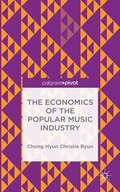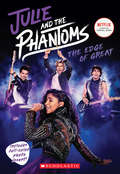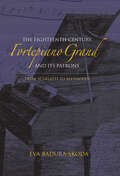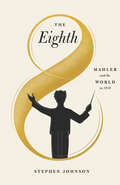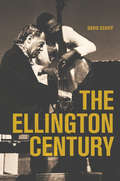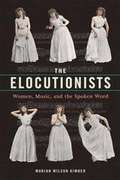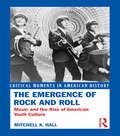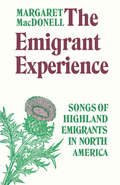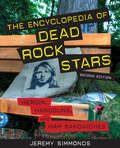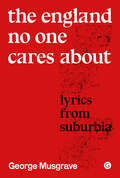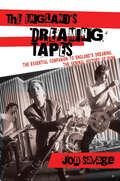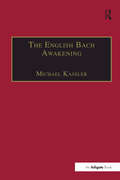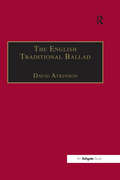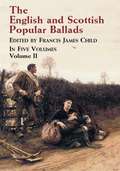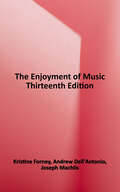- Table View
- List View
The Economics of the Popular Music Industry: Modeling From Microeconomic Theory And Industrial Organization
by Chong Hyun Christie ByunThis Palgrave Pivot uses modeling from microeconomic theory and industrial organization to demonstrate how consumers and producers have responded to major changes in the music industry. Byun examines the important role of technology in changing its structure, particularly as new methods of creating and accessing music prove to be a double-edged sword for creators and producers. An underlying theme in the project is the question of how the business of music affects creativity, and how artists continue to produce creative output in the face of business pressures, the erosion of copyright enforcement, and rampant online piracy. In addition to being a useful resource for economists interested in the music industry, this approachable Pivot is also ideal for business and music majors studying the effect of technology on their chosen fields.
The Economics of the Popular Music Industry: Modelling from Microeconomic Theory and Industrial Organization
by Christie ByunThis book uses economic theory to explain how consumers and producers have responded to major changes in the music industry. Byun examines the important role of technology in changing its structure, particularly as new methods of creating and accessing music prove to be a double-edged sword for creators and producers. This second edition includes new information about concert attendance and live performance in the COVID era and what followed, as well as the resultant economic impacts on the industry. Throughout the book, Byun questions how the business of music affects creativity and the extent to which this impacts the creative output of the individual artist. Chapters also address copyright enforcement and online piracy. This is an approachable resource for economists interested in the music industry as well as business and music majors studying the ways in which technology can impact a creative process.
The Edge of Great (Julie and the Phantoms, Season One Novelization)
by Micol OstowAfter the passing of her mom, Julie has lost her passion for music and is on the verge of being kicked out of her performing arts high school. That is, until she makes the ultimate comeback with her new band, Julie and the Phantoms. There's only one catch: all of her bandmates are ghosts. Back in the 1990s, Luke, Reggie, and Alex were on the cusp of rock stardom with their band, Sunset Curve, before an unfortunate encounter with Los Angeles street food brought their rock band dreamsand livesto an end. Now, with Julie as their lead singer, the guys have a second chance to make it big and to help Julie discover the real power of music. This novel based on season one of the hit Netflix series Julie and the Phantoms is told in alternating points of view and includes exclusive story content not seen on the show!
The Eighteenth-Century Fortepiano Grand and Its Patrons: From Scarlatti to Beethoven
by Eva Badura-Skoda“Badura-Skoda addresses the place of the piano in the eighteenth century from the perspective of a scholar and performer” (Eighteenth-Century Music).In the late seventeenth century, Italian musician and inventor Bartolomeo Cristofori developed a new musical instrument—his cembalo che fa il piano e forte, which allowed keyboard players flexible dynamic gradation. This innovation, which came to be known as the hammer-harpsichord or fortepiano grand, was slow to catch on in musical circles. However, as renowned piano historian Eva Badura-Skoda demonstrates, the instrument inspired new keyboard techniques and performance practices and was eagerly adopted by virtuosos of the age, including Scarlatti, J. S. Bach, Clementi, Haydn, Mozart, and Beethoven. Presenting a rich array of archival evidence, Badura-Skoda traces the construction and use of the fortepiano grand across the musical cultures of eighteenth-century Europe, providing a valuable resource for music historians, organologists, and performers.“Badura-Skoda has written a remarkable volume, the result of a lifetime of scholarly research and investigation. . . . Essential.” —Choice
The Eighth: Mahler and the World in 1910
by Stephen JohnsonSeptember 12, 1910: The world premiere of Gustav Mahler’s Eighth Symphony and the artistic breakthrough for which the composer had yearned all his life. Munich’s new Musik Festhalle was filled to capacity on two successive evenings for the performances, which were received with rapturous applause. Representatives of many European royal houses were in attendance, along with an array of stars from the musical and literary world, including Thomas Mann and the young Arnold Schoenberg. Also present were Alma Mahler, the composer’s wife, and Alma’s longtime lover, the architect Walter Gropius. Knowledge of their relationship would precipitate an emotional crisis in Mahler that, compounded with his heart condition and the loss of his young daughter Maria, would lead to his premature death the next year. In The Eighth, Stephen Johnson provides a masterful account of the symphony’s far-reaching consequences and its effect on composers, conductors, and writers of the time. The Eighth looks behind the scenes at the demanding one-week rehearsal period leading up to the premiere—something unheard of at the time—and provides fascinating insight into Mahler’s compositional habits, his busy life as a conductor, his philosophical and literary interests, and his personal and professional relationships. Johnson expertly contextualizes Mahler’s work among the prevailing attitudes and political climate of his age, considering the art, science, technology, and mass entertainment that informed the world in 1910. The Eighth is an absorbing history of a musical masterpiece and the troubled man who created it.
The Elements of Expressive Conducting
by Brian Doyle Jerald Schwiebert Michael Haithcock Kevin GeraldiThe Elements of Expressive Conducting begins with a synthesis of various movement theories which allow beginning conducting students to understand how best to use their body as an expressive instrument. Strategies for developing musical expression beyond pedagogical execution are discussed in each chapter. The text further explores merging musical preparation with a healthy, tension-free approach to an individual's movement. Readers will also find strategies for developing the coordination between the ear and body; ways to transfer "every day" movements to the art of conducting; and suggestions for building to a professional level of success.
The Ellington Century
by David SchiffBreaking down walls between genres that are usually discussed separately--classical, jazz, and popular--this highly engaging book offers a compelling new integrated view of twentieth-century music. Placing Duke Ellington (1899-1974) at the center of the story, David Schiff explores music written during the composer's lifetime in terms of broad ideas such as rhythm, melody, and harmony. He shows how composers and performers across genres shared the common pursuit of representing the rapidly changing conditions of modern life. The Ellington Century demonstrates how Duke Ellington's music is as vital to musical modernism as anything by Stravinsky, more influential than anything by Schoenberg, and has had a lasting impact on jazz and pop that reaches from Gershwin to contemporary R&B.
The Elocutionists: Women, Music, and the Spoken Word
by Marian Wilson KimberEmerging in the 1850s, elocutionists recited poetry or drama with music to create a new type of performance. The genre--dominated by women--achieved remarkable popularity. Yet the elocutionists and their art fell into total obscurity during the twentieth century. Marian Wilson Kimber restores elocution with music to its rightful place in performance history. Gazing through the lenses of gender and genre, Wilson Kimber argues that these female artists transgressed the previous boundaries between private and public domains. Their performances advocated for female agency while also contributing to a new social construction of gender. Elocutionists, proud purveyors of wholesome entertainment, pointedly contrasted their "acceptable" feminine attributes against those of morally suspect actresses. As Wilson Kimber shows, their influence far outlived their heyday. Women, the primary composers of melodramatic compositions, did nothing less than create a tradition that helped shape the history of American music.
The Emergence of Rock and Roll: Music and the Rise of American Youth Culture (Critical Moments in American History)
by Mitchell K. HallRock and roll music evolved in the United States during the late 1940s and 1950s, as a combination of African American blues, country, pop, and gospel music produced a new musical genre. Even as it captured the ears of the nation, rock and roll was the subject of controversy and contention. The music intertwined with the social, political, and economic changes reshaping America and contributed to the rise of the youth culture that remains a potent cultural force today. A comprehensive understanding of post-World War II U.S. history would be incomplete without a basic knowledge of this cultural phenomenon and its widespread impact. In this short book, bolstered by primary source documents, Mitchell K. Hall explores the change in musical style represented by rock and roll, changes in technology and business practices, regional and racial implications of this new music, and the global influences of the music. The Emergence of Rock and Roll explains the huge influence that one cultural moment can have in the history of a nation.
The Emigrant Experience: Songs of Highland Emigrants in North America (The Royal Society of Canada Special Publications)
by Margaret MacDonellEvery man has a story to tell and this was no less true of the hundreds of emigrants from the Highlands and the Hebrides who crossed the Atlantic from the late eighteenth century to the early twentieth century to settle in North America. This selection of Scottish Gaelic songs brings to light the revealing and often touching poems of some twenty such emigrants. Focusing on themes of emigration and exile, their subjects range from the biblical motif of liberation from tyranny (pre-destined by the Creator who provided a land of bounty across the seas), to the happier future anticipated for his daughter by a loyalist fugitive in North Carolina; from a sense of security on the part of a clergyman settled in Pictou County after the disruption in his homeland, to the disenchantment of an emigrant to Manitoba who longed to move on to North Dakota. Their tone may be lyrical, elegaic, or satirical. Songs from various parts of the new world – the Carolinas, Nova Scotia, Prince Edward Island, Ontario, and the Canadian west – are included in Gaelic with a facing English translation. A short biography of each bard prefaces the selections attributed to him or her. Detailed notes provide a guide to sources and variant texts, elucidate obscure passages, and define the social and cultural context in which the songs originated. An appendix reproduces the tunes for nine of these songs.This is a book that will inform and entertain both the specialist and the general reader.
The Empire at the Opéra: Theatre, Power and Music in Second Empire Paris (Elements in Musical Theatre)
by Mark EveristAlthough nineteenth-century legislation had tried to ensure a precise separation between genre and institution for Parisian music in the theatre, it had inadvertently laid out a field on which the politics of genre could be played out as agents and actors of all types deployed various forms of artistic power. During the Second Empire, from 1854 until 1870, the state took over day-to-day control of the Opéra in ways that were without precedent. Every element of the Opéra's activity was subjugated to the exigency of Empire; the selection or artists, works and more general questions of artistic policy were handed over to politicians. The Opéra effectively became a branch of government. The result was a stagnation of the Opéra's repertory, and beneficiaries were the composers of larger-scale works for competing organisations: the Opéra Comique and the Théâtre Lyrique.
The Encyclopedia of Dead Rock Stars: Heroin, Handguns, and Ham Sandwiches
by Jeremy SimmondsThe bible of music's deceased idols--Jeff Buckley, Sid Vicious, Jimi Hendrix, Tupac, Elvis--this is the ultimate record of all those who arrived, rocked, and checked out over the last 40-odd years of fast cars, private jets, hard drugs, and reckless living. The truths behind thousands of fascinating stories--such as how Buddy Holly only decided to fly so he'd have time to finish his laundry--are coupled with perennial questions, including Which band boasts the most dead members? and Who had the bright idea of changing a light bulb while standing in the shower?, as well as a few tales of lesser-known rock tragedies. Updated to include all the rock deaths since the previous edition--including Ike Turner, Dan Fogelberg, Bo Diddley, Isaac Hayes, Eartha Kitt, Michael Jackson, Clarence Clemons, Amy Winehouse, and many, many more--this new edition has been comprehensively revised throughout. An indispensable reference full of useful and useless information, with hundreds of photos of the good, the bad, and the silly, this collection is guaranteed to rock the world of trivia buffs and diehards alike.
The Encyclopedia of Disc Music Boxes 1881-1920: A History, Catalog Raisonné, and Appreciation
by Q. David BowersDisc Music Boxes preceded the phonograph as a way of listening to popular tunes and classical music. They were located in private homes and public places of entertainment. This is an extensive encyclopedia for collectors of these disc music boxes. The DAISY version is considerably indexed for easy navigation.
The Endless Refrain: Memory, Nostalgia, and the Threat to New Music
by David RowellA veteran music journalist argues that the rise of music streaming and the consolidation of digital platforms is decimating the musical landscape, with dire consequences for the future of our culture …In The Endless Refrain, former Washington Post writer and editor David Rowell lays out how commercial and cultural forces have laid waste to the cultural ecosystems that have produced decades of great American music. From the scorched-earth demonetizing of artist revenue accomplished by Spotify and its ilk to the rise of dead artists &“touring&” via hologram, Rowell examines how a perfect storm of conditions have drained our shared musical landscape of vitality.Combining personal memoir, intimate on-the-ground reporting, industry research, and cultural criticism, Rowell&’s book is a powerful indictment of a music culture gone awry, driven by conformity and subverted by the ways the internet and media influence what we listen to and how we listen to it.
The England No One Cares About: Lyrics from Suburbia (Goldsmiths Press / Sonics Series)
by George MusgraveAn exploration of the much-derided English suburbs through rap music.There are many different Englands. From the much-romanticized rolling countryside, to the cosmopolitanism of the inner cities (embraced by some as progressive, multicultural enlightenment and derided by others as the playground of a self-righteous metropolitan elite), or the disparagingly named "left behind" communities which, post-Brexit, have so interested political parties and pundits, demographers and statisticians.But there is also an England no one cares about. The England of semi-detached houses and clean driveways for multiple cars devotedly washed on Sundays, of "twitching curtains" and Laura Ashley sofas; of cul-de-sacs to nowhere and exaggerated accents; of late night drives to petrol stations on A roads, fake IDs tested in Harvesters, and faded tracksuits and over-gelled hair in Toby Carverys; of questionable hash from a "mate of a mate" and two-litre bottles of White Lightning from Budgens consumed in a kids playground. Much derided. Unglamorous, ordinary; cultural vacuity and small "c" conservatism. A hodgepodge. An—apparently—middling, middle-of-the-road middle-England of middle-class middle-mindedness. Part poetry anthology, part academic study into placemaking, and part autoethnography, The England No One Cares About innovatively brings together academic discussions of the ethnographic potential of lyrics, scholastic representations of suburbia, and thematic analysis to explore how rap music can illuminate the experiences of young men growing up in suburbia. This takes place by exploring the author&’s own annotated lyrics from his career as a musician known as Context where he was referred to by the BBC as "Middle England&’s Poet Laureate."
The England's Dreaming Tapes
by Jon SavageJon Savage's 1991 book, England's Dreaming: Anarchy, Sex Pistols, Punk Rock, and Beyond, was hailed by the New York Times Book Review as "the definitive history of the English punk movement." Widely imitated but never equaled, it remains that rare work of music history that appeals to music fans, critics, and scholars alike. In researching England's Dreaming, Savage conducted hundreds of hours of interviews of which only a fraction made it into the finished book. Now, in The England's Dreaming Tapes, Savage makes available for the first time the full, uncut, sensational story behind the cultural moment that was punk.Here is the story of a generation that changed the world in just a few months in 1976, as told by the scene's major figures: all four original Sex Pistols as well as Joe Strummer, Chrissie Hynde, Jordan, Siouxsie Sioux, Viv Albertine, Adam Ant, Lee Black Childers, Howard Devoto, Pete Shelley, Syl Sylvain, Debbie Wilson, Tony Wilson, Jah Wobble, and many others. Together, they offer a sweeping history of the late 1960s and the 1970s-not just the era's music, but also its radical politics, social issues, fashion, and culture.An invaluable source of information about a movement that has become obscured by myth, these vivid, unvarnished interviews were conducted when punk was only a decade old. In many cases, this was the first time that the subjects had talked about the period. The interviews describe the founding of the Sex Pistols; 430 King's Road, site of the legendary boutique Sex, which helped establish the punk aesthetic; punk rock New York; the cultural landscapes of London and its suburbs; the writers who covered punk; and the Manchester music scene centered around Factory Records.With The England's Dreaming Tapes, Savage gives us the first and final word on the music, fashion, and attitude that defined this influential and incendiary era.
The English Bach Awakening: Knowledge of J.S. Bach and his Music in England, 1750-1830 (Music In Nineteenth-century Britain Ser.)
by Michael KasslerThe English Bach Awakening concerns the introduction into England of J.S. Bach's music and information about him. Hitherto this subject has been called 'the English Bach revival', but that is a misnomer. 'Revival' implies prior life, yet no reference to Bach or to his music is known to have been made in England during his lifetime (1685-1750). The book begins with a comprehensive chronology of the English Bach Awakening. Eight chapters follow, written by Dr Philip Olleson, Dr Yo Tomita and the editor, Michael Kassler, which treat particular parts of the Awakening and show how they developed. A focus of the book is the history of the manuscripts and the printed editions of Bach's '48' - The Well-tempered Clavier - in England at this time, and its culmination in the 'analysed' edition that Samuel Wesley and Charles Frederick Horn published in 1810-1813 and later revised. Wesley's multifaceted role in the Bach Awakening is detailed, as are the several efforts that were made to translate Forkel's biography of Bach into English. A chapter is devoted to A.F.C. Kollmann's endeavour to prove the regularity of Bach's Chromatic Fantasy, and the book concludes with a discussion of portraits of Bach in England before 1830.
The English Musical Renaissance and the Press 1850-1914: Watchmen of Music (Music In Nineteenth-century Britain Ser.)
by Meirion HughesThe importance of nineteenth-century writing about culture has long been accepted by scholars, yet so far as music criticism is concerned, Victorian England has been an area of scholarly neglect. This state of affairs is all the more surprising given that the quantity of such criticism in the Victorian and Edwardian press was vast, much of it displaying a richness and diversity of critical perspectives. Through the study of music criticism from several key newspapers and journals (specifically The Times, Daily Telegraph, Athenaeum and The Musical Times), this book examines the reception history of new English music in the period surveyed and assesses its cultural, social and political, importance. Music critics projected and promoted English composers to create a national music of which England could be proud. J A Fuller Maitland, critic on The Times, described music journalists as 'watchmen on the walls of music', and Meirion Hughes extends this metaphor to explore their crucial role in building and safeguarding what came to be known as the English Musical Renaissance. Part One of the book looks at the critics in the context of the publications for which they worked, while Part Two focuses on the relationship between the watchmen-critics and three composers: Arthur Sullivan, Hubert Parry and Edward Elgar. Hughes argues that the English Musical Renaissance was ultimately a success thanks largely to the work of the critics. In so doing, he provides a major re-evaluation of the impact of journalism on British music history.
The English Traditional Ballad: Theory, Method, and Practice (Ashgate Popular And Folk Music Ser.)
by David AtkinsonBallads are a fascinating subject of study not least because of their endless variety. It is quite remarkable that ballads taken down or recorded from singers separated by centuries in time and by hundreds of kilometres in distance, should be both different and yet recognizably the same. In The English Traditional Ballad, David Atkinson examines the ways in which the body of ballads known in England make reference both to ballads from elsewhere and to other English folk songs. The book outlines current theoretical directions in ballad scholarship: structuralism, traditional referentiality, genre and context, print and oral transmission, and the theory of tradition and revival. These are combined to offer readers a method of approaching the central issue in ballad studies - the creation of meaning(s) out of ballad texts. Atkinson focuses on some of the most interesting problems in ballad studies: the 'wit-combat' in versions of The Unquiet Grave; variable perspectives in comic ballads about marriage; incest as a ballad theme; problems of feminine motivation in ballads like The Outlandish Knight and The Broomfield Hill; murder ballads and murder in other instances of early popular literature. Through discussion of these issues and themes in ballad texts, the book outlines a way of tracing tradition(s) in English balladry, while recognizing that ballad tradition is far from being simply chronological and linear.
The English and Scottish Popular Ballads, Volume 1
by Francis James ChildThe rich field of English balladry was virgin territory before Francis James Child entered it. The few published ballad editions that existed were unreliable, filled with unacknowledged editorial changes and distortions of the original manuscripts. Professor Child compiled all the extant ballads with all known variants, and made them available for the first time — together with his invaluable commentary that prefaces each work — in a single source that maintained absolute fidelity to the original texts. Published between 1882 and 1898, the original ten-part study became the definitive collection of popular ballads in the English language, never to be superceded. To this day, scholars and devotees speak of "The Child Ballads" with the awe and respect generated by few other literary works. Volume 1: Parts I and II of the original set, ballads 1-53 including "Edward," "Lord Randal," "Tam Lin," "Lady Isabel and the Elf-Knight," "Earl Brand," "Thomas Rymer," more. Biographical sketch of Child by Prof. Kittredge, Child's portrait, additions and corrections.
The English and Scottish Popular Ballads, Volume 2
by Francis James ChildPublished between 1882 and 1898, this definitive collection compiles all the extant ballads with all known variants and features the Child's commentary for each work. Volume II includes Parts III & IV of the original set — ballads 54–113: "Sir Patrick Spens," "Johnie Scot," "Child Maurice," "Fair Margaret and Sweet William," more.
The English and Scottish Popular Ballads, Volume 3
by Francis James ChildPublished between 1882 and 1898, this definitive collection compiles all the extant ballads with all known variants and features Child's commentary for each work. Volume III includes Parts V and VI of the original set — ballads 114–188: "Mary Hamilton," "Flodden Field," "Sir Andrew Barton," and more than 30 ballads about Robin Hood.
The English and Scottish Popular Ballads, Volume 4
by Francis James ChildPublished between 1882 and 1898, this definitive collection compiles all the extant ballads with all known variants and features Child's commentary for each work. Volume IV includes Parts VII and VIII of the original set — ballads 189-265: including "Rob Roy," "Sir James the Rose," "Geordie," "The Gypsy Laddie," "The New-Slain Knight," more.
The English and Scottish Popular Ballads, Volume 5
by Francis James ChildPublished between 1882 and 1898, this definitive collection compiles all the extant ballads with all known variants and features Child's commentary for each work. Volume 5 includes Parts IX and X of the original set — ballads 266-305 — plus a 3000-item bibliography, indexes, glossary, musical selections and an essay by Walter Morris Hart.
The Enjoyment Of Music (Thirteenth Edition)
by Joseph Machlis Kristine Forney Andrew Dell'AntonioThe Enjoyment of Music continues to teach students how to listen and connect to any kind of music. After more than fifty years of successfully preparing students for a lifetime of informed listening, the Twelfth Edition raises the bar with an expanded repertory of appealing music, an exciting new listening and assessment pedagogy, and the richest and most user-friendly online resources available to students today.
